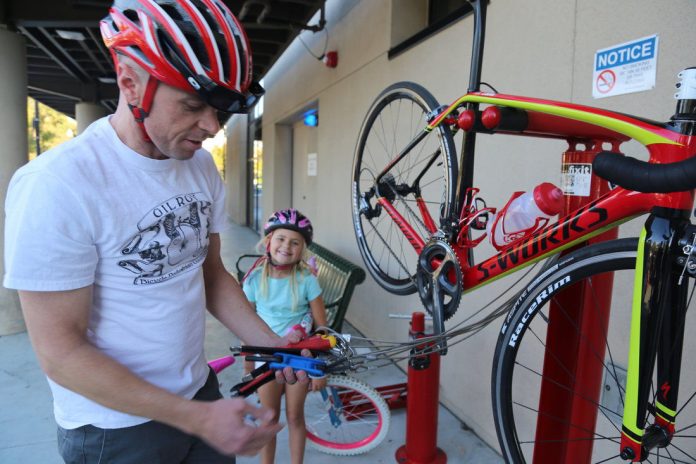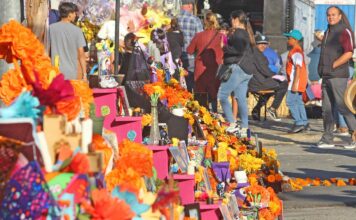For members of the City of Gilroy Bicycle and Pedestrian Commission, the ride has been a little bumpy. For Zach Hilton, a first-year chairperson and a Gilroyan who works as a firefighter in Oakland, maneuvering around the bumps in the road are worth the effort to make Gilroy a safer and more enjoyable community for bicyclist and pedestrians. Despite his optimism, getting through government red tape can be frustrating.
“I’ve only been on the board since January, but I discovered that everything takes so long, it’s a process,” Hilton said. “Government is slow.”
The Bicycle and Pedestrian Commission came into the year with three main projects in mind: revitalize Gourmet Alley, install bike racks downtown and build a BMX pump track. Early this summer the city approved a one-time expenditure for the installation, but in recent months the project seems to have slipped through the cracks at city hall.
“I think we were the only commission to actually bring forward any projects,” Hilton said. “When Gabe Gonzalez presented other city projects, ours was listed as an outside request. We had to ask to be involved in the budget process. When we asked to be involved, all the other departments had turned their ideas in for finance. When we finally got the opportunity, everything had already been submitted to other departments.”
The idea for the bike racks was sparked by the gift from Sunrise Rotary members. Problems arose almost immediately. Their desire to put Sunrise Rotary’s logo on the bike-shaped rack conflicted with the city’s downtown sign ordinance.
“If they wanted to have their logo in the front spoke of the rack, that would be considered a sign that’s against the current code,” Hilton said. “To change the code the city would have to run through the process of getting staff time, public hearings and posting it in the newspaper and get all of that approved by the city council.”
Today the City of Gilroy is looking for 21 applicants to the 15 various city boards, which aside from the Bicycle and Pedestrian Commission includes the Planning Commission, the Arts and Culture Commission and the Historic Heritage Commission among others. For more information visit cityofgilroy.org/148/Boards-Commissions-Committees. While the commissions and boards serve in advisory roles only, they provide an essential conduit between the city’s government and the people.
“It’s not like a ‘Mother, may I’ situation with the commissions,” Hilton said. If the commissions want to come up with their own plans and strategic goals, they can, they’re allowed to and our bike commission is a perfect example.”
Many of the commissions and boards are having difficulty meeting quorums. Aside from training on how to operate under the Brown Act, which guarantees the public’s right to participate in government business, there is no additional training. For Hilton, his first year on the commission has been like a self-taught City Government 101 class. Hilton, by his own initiative, wrote the bike rack proposal for the city without being asked.
Among the Bicycle Commission’s challenges, working with the city has been hindered by a lack of available staff.
In a document crafted by the Bike Commission that planned the installation of ten bike racks in the downtown, the total cost of approximately $7,500 was being offset by a $10,000 grant discovered by the commission. The commission offered to assist interim City Traffic Engineer Michael Fisher to write the grant, but the proposal was rejected by Kristi Abrams because city staff can only work on grants of at least $100,000.
“I wish I knew,” said Hilton when asked when the new bike racks would be installed. “We’re done with the traffic and bike plan; it’s finished. It needs to be presented to the city council to get their input, so it’s not finalized. The Bicycle and Pedestrian Commission and the Downtown Business Association has approved it and it’s gone through city planning.”
The racks, designed by Dero Bike Racks, are to be customized and have been supported by Gary Walton of the Gilroy Downtown Business Association. John Buchanan, who was one of the main drivers behind the Downtown Paseo Project, designed the bike corral at the Gilroy Public Library and suggested Dero for the project.
Walton, has pledged to donate a Dero Fixit Station, like the one that was recently installed at the Gilroy Public Library, to downtown Gilroy. The station, sturdily bolted into the ground, has all the tools needed to fix a bike and a pump for flat-tire repairs.
Another priority for the Bicycle and Pedestrian Commission is to promote safety. For Hilton, aside from 1st Street, which he sees a being very dangerous until its repaved, Gilroy is a safe place for bicyclist.
“I don’t feel uncomfortable in any part of the city, especially downtown,” Hilton said of the sharrows in town, which are street markings that indicate that indicate where bikes should travel. “Most of the streets are narrow enough that I’ll ride right down the center of the street and feel comfortable. You’ll be seeing more sharrows in town. Each time they redo the pavement, you’ll see fresh striping.”
Despite these difficulties, Hilton feels that it’s important to align the Bike Commission’s goals with those of the city.
“With all three of those priorities, we listed what our strategic goals were and how they lined up with the goals of the city,” said Hilton, who would like to see the Bicycle and Pedestrian Commission’s goals align with the city’s.
As of today there are 60 spots for bicycle parking downtown, but the Bicycle Commission has plans to bump that number up to almost 300 parking spots. The bike racks are designed to be flexible and will be able to be moved depending on where the greatest needs are.
“Most of the time when you’re going to ride your bike to town, you’re going to stay there,” Hilton said.














